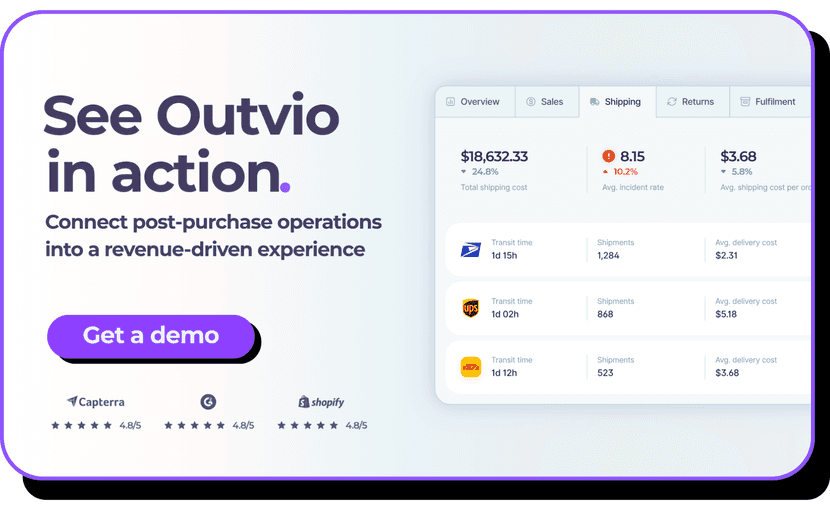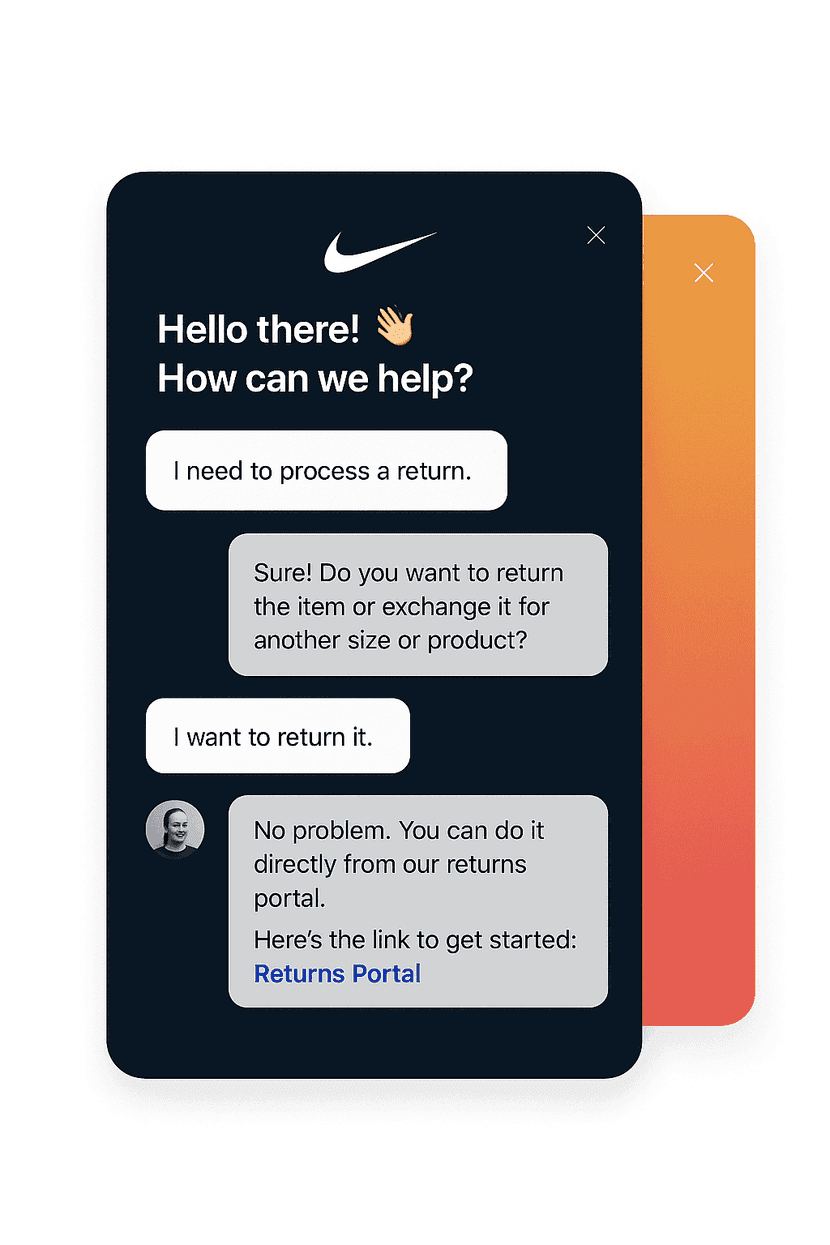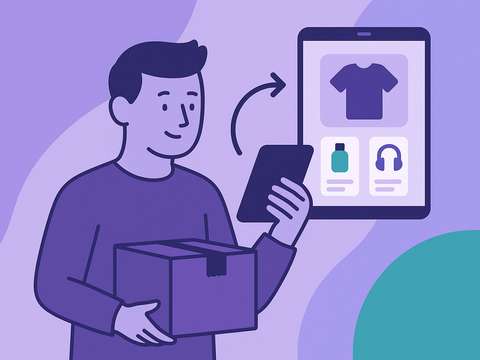If you manage an eCommerce store, you know firsthand how costly and disruptive product returns can be, from squeezing profit margins to complicating logistics and impacting customer satisfaction.
Chatbots have emerged as a strategic solution for eCommerce professionals looking to minimize unnecessary returns.
By providing real-time support, clarifying product specifications, and guiding customers through sizing or compatibility questions, chatbots proactively reduce order mistakes and set clear expectations before purchase.
Leading retailers like H&M already leverage chatbots to decrease returns related to product confusion or misorders.
At Outvio, many e-commerce businesses are already reducing their returns by using our chat, with some seeing a reduction in return rates of up to 15%. Since we know the best strategies, we will explain below what these strategies are and how you can apply them to your own e-commerce business.

Why returns are so costly in eCommerce
Research shows that up to 30% of your online sales might be returned, while only about 9% of your in-store purchases are sent back. In certain categories, such as fashion, your return rates could be even higher.
The 2023 National Retail Federation report showed that U.S. retailers handled more than $816 billion in returns in 2022, which made up about 16.5% of total retail sales.
In addition, every return you process comes with hidden costs:
- You pay for shipping and restocking
- You lose revenue if you can’t resell items at full price
- Your customer service team faces a higher workload.
- You contribute to environmental impact due to increased logistics
Why chatbots matter in returns and exchange management
Using a chatbot for returns is a major advantage for eCommerce businesses. Instead of searching for contact details or waiting for replies, customers can start a return instantly by chatting with the bot and providing their order ID and email.
Advanced chatbots like Outvio’s handle the entire process: creating return labels, scheduling pick-ups, and keeping everyone updated. This automation is vital for high-volume stores, as it reduces manual work, errors, and costs.

How a chatbot for returns works
To streamline returns, set up triggers and workflows in your chatbot. For example, when a customer starts a return, the system collects the order number, checks eligibility, and guides them through the steps.
If approved, it asks for the reason for the return or offers exchanges, then generates a shipping label or QR code with clear instructions.
- If a customer wants to return shoes that don’t fit, the chatbot checks if the return window is open and offers an exchange or refund
- For exchanges, the workflow shows available options, making the process easy and interactive, while the system manages logistics
The Outvio chatbot already has a detailed return management system set up, so you can handle return requests automatically without any extra setup.
How chatbots reduce your eCommerce returns
1. Offer instant, accurate product information
Your customers might return items they purchase online if the products don’t meet their expectations.
By implementing chatbots, you can provide customers with quick and accurate information about your products at any time.
Customers can ask about size, material, stock availability, or compatibility with other products. This reduces confusion and builds their confidence in making a purchase, decreasing the likelihood of returns due to mismatched expectations.
Certain chatbots can even proactively offer assistance when a customer appears to need help, delivering immediate support.
Example: You can configure your system to direct customers to a FAQ page whenever they have questions about a product, ensuring they receive fast and helpful answers.
2. Promote exchanges with store credit and automated product suggestions
Encourage your customers not to request a refund immediately when they want to return a product.
It's more effective if your chatbot directs them to a returns portal where they are prompted to exchange the product or accept store credit instead.
For instance, you can offer a 5% discount on similar products or highlight higher-value items, giving your customers a better deal and more reasons to exchange rather than refund.
This approach helps your customers see exchanges as an attractive alternative before considering a refund.
Leveraging your chatbot to promote exchanges and store credit is a proven way to retain revenue and minimize returns. In fact, some Outvio clients have saved nearly 200,000 euros in 12 months by implementing this strategy in their returns portal.
3. Show personalized recommendations in the chatbot
AI-powered chatbots analyze your customers' unique data, including their browsing history, previous purchases, and past returns.
By understanding these patterns, chatbots can recommend products that are more likely to match your customers' preferences and needs.
This personalized approach increases customer satisfaction and reduces returns due to mismatched expectations or unsuitable products.

4. Clarify your store’s return and exchange policies
Chatbots can quickly provide your ecommerce business with clear and updated information about return times, policies, and procedures, making it easier for you to manage returns.
If your return and exchange policies are unclear, it can lead to unnecessary returns or dissatisfied customers.
Depending on your store's return policy, the chatbot can enforce different rules to process your returns efficiently.
For example, the return process may vary based on the customer's identity, location, or the product type. When a return is requested, the chatbot can suggest alternatives like exchanging for a different size or color, or offering a discount code for future purchases, tailoring its response to each situation.ation.
5. Guide the customer through your post-purchase journey
Chatbots can enhance your customers' shopping experience by providing support before, during, and after their purchases. They can:
- Track customer orders and deliver real-time shipping updates
- Assist with troubleshooting product issues for your customers
- Guide customers through setup or usage instructions
- Help customers initiate returns or exchanges by offering clear, step-by-step guidance
This ongoing support helps prevent misunderstandings and quickly resolves customer issues, reducing the number of returns caused by confusion or frustration.
6. Reduce fraudulent returns
Another advanced feature of the chatbot is its ability to detect and prevent fraudulent returns.
By analyzing customer behavior patterns, order histories, and return frequencies, the system can identify suspicious attempts and alert your team before any requests are processed.
When such activity is detected, the chatbot can trigger special anti-fraud measures, such as requiring identification from the customer or asking them to upload a photo of the product.
This helps you protect your ecommerce business from return policy abuse, ensuring that only legitimate requests are processed and supporting the profitability and trustworthiness of your online store.
7. Collect and analyze your chatbot’s return data
When you implement chatbots to handle returns in your store, the system can collect structured feedback on the reasons customers are sending items back.
This data is extremely valuable for your ecommerce operations, as it enables you to identify trends—like recurring product problems or misleading descriptions—so you can make targeted improvements to your product range or website.
By addressing these underlying issues, you can proactively reduce future returns.
This approach can also help you to:
- Spot patterns in returns by category, supplier, or customer group
- Enhance your products, supplier agreements, and service based on return data
- Receive instant notifications for spikes in returns, allowing for quick action
- Connect return data with your inventory to better forecast demand
- Engage with frequent returners to offer support or incentives
- Leverage chatbot data to update your policies and further improve the customer experience
Measuring and optimizing chatbot performance
To measure your chatbot's effectiveness, track metrics like user retention, response time, and customer satisfaction.
A Salesforce study found that 69% of U.S. consumers use chatbots for quick chats, but only 17% enjoy the experience, highlighting the need to assess user satisfaction.
But if you want to see if your chatbot is actually lowering your returns, there are other metrics you should look at.
The main numbers to check when studying returns are your return rate, how often products are exchanged, how many customers stay after a return, and how often returns happen within a certain time.
It's also useful to check the ratio of exchanges to returns, how many customers stay after an exchange or return, and how these numbers change over time. This information helps you see if your plans to lower returns and keep customers are working.
With Outvio, you can even track in real time how much revenue you’re earning through product exchange upselling.
Overcoming limitations: when chatbots need a human touch
While chatbots handle most of your routine inquiries efficiently, they may struggle with more complex, nuanced, or emotionally sensitive situations.
For example, if you have technical troubleshooting needs, customer complaints, or requests that fall outside predefined scripts, automated systems can often pose significant challenges for you.
Chatbots might misinterpret your intent, fail to grasp your emotional context, or lack the flexibility to address your unique or unexpected issues.
These limitations highlight the ongoing difficulties in creating AI systems that can match the depth of your understanding and empathy when dealing with intricate or sensitive matters.
At Outvio, the chatbot detects your difficult questions and sends them to the right agent, so you receive fast and personalized help. This way, you get better service, save time, and enjoy a happier experience without having to do everything manually.
Find out why Outvio has the best chatbot to lower ecommerce returns without hurting your customer experience. Book a demo.




